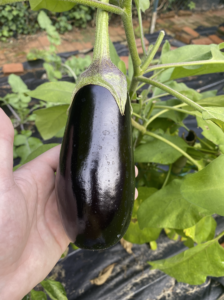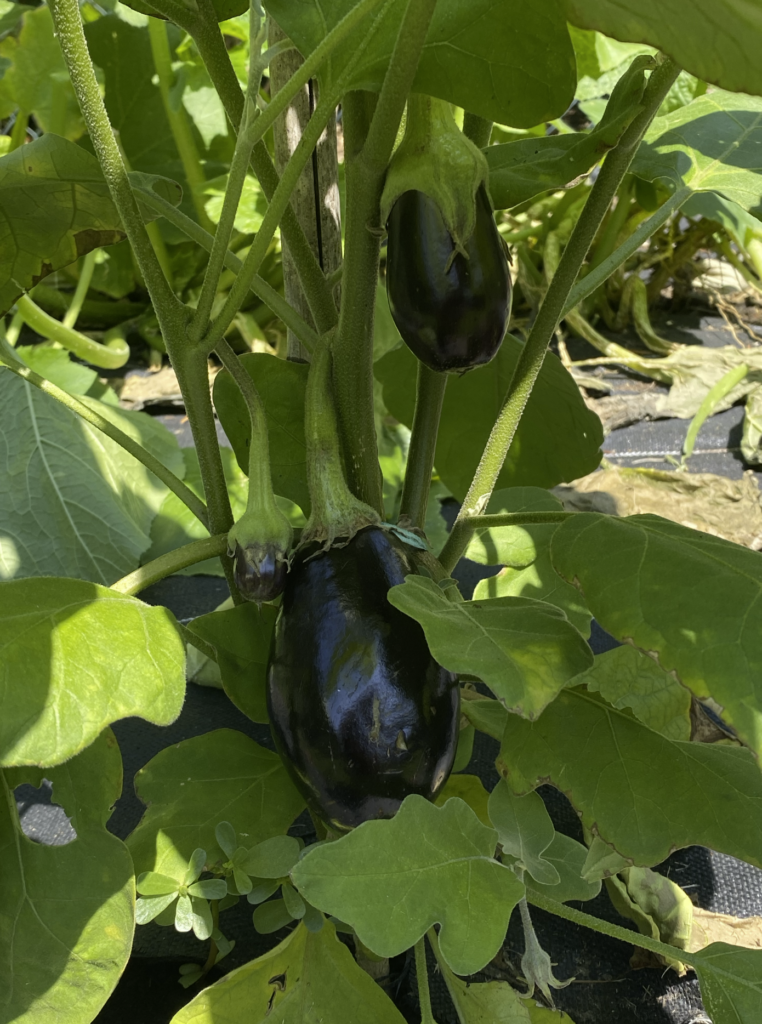Eggplant, aka aubergine, is a member of the nightshade family, similar to peppers and tomatoes. Eggplant is commonly colored purple but also has white variants. It is native to India and Southeast Asia, where it has been cultivated for thousands of years. During the Middle Ages it traveled and made its way over to the countries bordering the Mediterranean Sea. Eggplant has a very mild sweet flavor and is known for soaking up all the flavors of whatever else it was cooked with. It can be baked, broiled, mashed, roasted, and stir-friend. Some people have also served it as a steak on the grill after slicing it into 1.5-inch-thick slabs.
Eggplants are very nutritious and a great source of vitamin A, B1, B6, C, K, iron, potassium, magnesium, fiber, and calcium. The most recognizable is the Black Beauty, which is a large and long dark purple eggplant. The Black Beauty is also the varietal most commonly found in grocery stores. Some eggplants are also a rounder oval shape, like the Barbarella, Thai Kermit, or the Lavender Frog Egg. Asian varieties are more tender and delicate, while the European varieties tend to have a thicker tough skin.
How to Plant Eggplant
 Eggplants are perennial in some climates but are typically grown as annuals. They require full sun, an acidic 5.5 to 6.5 pH, and a well-drained loamy soil. If you are planning to grow outdoors, we recommend starting indoors then transplanting. Start indoors about 3-4 weeks before the last frost, then transplant outside 4-6 weeks after the last frost. Eggplants should be planted a quarter inch deep in trays. Transplants should be spaced about 24 inches apart, with 36 inches between rows. Apply a 5-10-5 npk fertilizer as needed.
Eggplants are perennial in some climates but are typically grown as annuals. They require full sun, an acidic 5.5 to 6.5 pH, and a well-drained loamy soil. If you are planning to grow outdoors, we recommend starting indoors then transplanting. Start indoors about 3-4 weeks before the last frost, then transplant outside 4-6 weeks after the last frost. Eggplants should be planted a quarter inch deep in trays. Transplants should be spaced about 24 inches apart, with 36 inches between rows. Apply a 5-10-5 npk fertilizer as needed.
If you’re planting in containers, eggplants need a large 4-to-5-gallon container. Depending on the size of the pot, you can plant multiple eggplants in each container, but they should be spaced at least 10 inches apart. The soil should be loamy. Too much sand or clay will prevent the eggplant from growing a substantial root system. As the seedlings begin to sprout in the container, thin the container so it only contains the largest plant. Eggplants prefer warmer weather, so if you’re planting in a container, choose a dark colored container so it absorbs the sun’s rays and warms the dirt more evenly. Ideal growing temperature for eggplants is 70F to 85F.
Due to the size of the eggplant, it is important to support it as it grows with a stake, trellis, or tomato cage. Make sure to stake the plant early as to not disturb its root system.
Some good companion plants for eggplants include green beans, peas, peppers, and tomatoes. The beans will deter potato beetles and planting herbs like dill or chives can help attract beneficial insects like ladybugs to eat other pests like aphids.
How to Harvest Eggplant
Eggplant grown outside from seed will take 100-120 days to mature, while transplants should take 60-80 days. Due to the long growing period, it is entirely normal to harvest your eggplants in late Summer or early Autumn. Eggplants benefit from being slightly under ripe during harvest to ensure it has sweeter flavors. Eggplants harvested late tend to be a lot more firm and bitter. The best way to tell if your eggplant is ready is to touch it. The eggplant skin should feel tight, glossy, and uniform in color. If you put light finger pressure on the eggplant, it should give in slightly and not tear. Always remove eggplants with shears, as the stem of an eggplant is very tough. If you try removing eggplant by pulling it, you risk damaging the plant.
Eggplant can be stored for 2 weeks at cellar temperature (50F to 55F) as long as the room maintains humidity well. If placed in a refrigerator, eggplant should last about a week. Avoid washing your eggplant before storing, as the water and cleaning sensation can strip the eggplant of its skin. Instead, gently brush off any dirt by hand or with a soft cloth.

Eggplant Pests and Diseases
Blight is a fungus that is caused from over watering and too much moisture. Blight will first cause the leaves to turn yellow, but it will eventually develop into a greenish grey mold. Eggplant afflicted with blight will eventually rot. There is no cure for blight, so the plant must be discarded.
Blossom-end Rot is caused when the eggplant is not properly watered or is lacking in calcium. It is characterized by large black or purple spots forming on the bottom of the eggplant. Blossom-end rot will not spread to other plants as long as you maintain them properly. Simply cut and remove the bad eggplant.
 Potato beetles will lay eggs on the underside of the eggplant leaves which will hatch into larvae that will eat through the eggplant. Applying neem oil and inviting beneficial predatory insects with native plants should get potato beetles under control.
Potato beetles will lay eggs on the underside of the eggplant leaves which will hatch into larvae that will eat through the eggplant. Applying neem oil and inviting beneficial predatory insects with native plants should get potato beetles under control.
Powdery Mildew is a type of fungus that will leave white cottony mold on your plants. It is caused from too much moisture. Apply neem oil at the fight sight of mildew or utilize a copper-based fungicide.
Tomato Hookworms are large caterpillars that will chew and eat the eggplant fruit and leaves. They will eventually cocoon into moths. Dill and marigolds can be planted to invite predatory insects that will eat the hookworms. They can also be hand removed and destroyed. If you’re facing an infestation, spraying a pesticide with the bacteria Bacillus thuringiensis (BT) should do the trick.
Whiteflies will leave a sticky honeydew secretion, similar to aphids, that will invite other insects like ants to invade your eggplants. Adult whiteflies can also carry different diseases and viruses that may infect your eggplant. Plant native flowers to invite beneficial insects to eat the whiteflies and hanging yellow sticky traps to catch the flies should help mitigate the problem. You can also apply neem oil or an insecticidal soap.
Starting an Eggplant Garden
Getting started with an eggplant garden is easy if you’re using the right garden planner. Hortisketch is an easy-to-use cloud-based garden planner and dynamic growing calendar. Simply click-and-drag your eggplant onto the canvas and the growing calendar will make sow, grow, and harvest recommendations based on your growing zone. Learn more about Hortisketch.

Contact Author
 info@gardensavvy.com
info@gardensavvy.com Recent Posts
- Smart Gardening: How Technology Is Revolutionizing Horticulture
- Understanding Gardening Zones: What You Need to Know
- The Right Tools For Your Gardening And Landscaping Needs
- Maximizing Your Harvest: Square Foot Gardening Chart for Beginners
- Holiday Garden Scents: Plants for Natural Aromatherapy in Your Home









